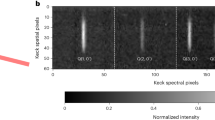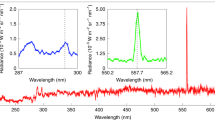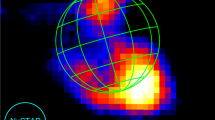Abstract
PROF. L. VEGARD'S recent note1 on the atomic lines in the auroral spectrum calls for some comments. While it is true that the presence of the Vegard-Kaplan bands in auroral spectra was first observed and interpreted by Vegard, R. Bernard reported an auroral spectrum in which these bands and the 3,470 line were unusually strong in comparison with the rest of the spectrum. The remarkable resemblance between this auroral spectrum and the high-pressure afterglow spectrum discovered by me led Bernard to interpret the radiation at 3,470 as a line rather than as the 2 P.G. (3–4) band as proposed by Vegard. One must give Bernard credit for an important new observation in recognizing this resemblance.
This is a preview of subscription content, access via your institution
Access options
Subscribe to this journal
Receive 51 print issues and online access
$199.00 per year
only $3.90 per issue
Buy this article
- Purchase on Springer Link
- Instant access to full article PDF
Prices may be subject to local taxes which are calculated during checkout
Similar content being viewed by others
References
Vegard, L., NATURE, 142, 670 (1938).
Kaplan, J., Pub. Astr. Soc. Pac., 47, 257 (1935).
Author information
Authors and Affiliations
Rights and permissions
About this article
Cite this article
KAPLAN, J. Atomic Lines in the Auroral Spectrum. Nature 143, 278–279 (1939). https://doi.org/10.1038/143278b0
Issue Date:
DOI: https://doi.org/10.1038/143278b0
Comments
By submitting a comment you agree to abide by our Terms and Community Guidelines. If you find something abusive or that does not comply with our terms or guidelines please flag it as inappropriate.



